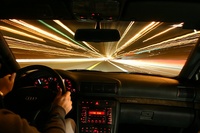Memorial Day Starts Peak Driving Season, with Nighttime Drivers at Greater Risk
National Road Safety Foundation offers tips to stay awake at the wheel
NEW YORK, May 24, 2007-- Memorial Day marks the start of the busiest time on roads nationwide, with nighttime drivers often at greater risk than those driving during the day.
The National Road Safety Foundation, Inc. (NRSF), a non-profit group that provides free driver safety programs for schools and other organizations, says the increase in recreational driving, coupled with more nighttime driving can be a dangerous combination.
"Drowsiness is a condition most drivers fail to recognize, and it can be as dangerous as drinking and driving," says Adele Kristiansson, NRSF Director of Marketing and Legislative Affairs. "Studies show 60 percent of us have driven while feeling fatigued, and more than a third admit to falling asleep at the wheel in the past year. Sleep-induced crashes are often very serious, since the driver does not take evasive or corrective action as the vehicle loses control."
Some signs that a driver is drowsy include: -- Difficulty focusing; frequent blinking, head nods, crankiness -- Daydreaming, not remembering the last few miles driven, missing exits -- Repeated yawning or rubbing eyes -- Drifting out of lane, tailgating or hitting shoulder rumble strips.
A driver experiencing any of these warning signs should pull over at the next exit or a safe rest area and take a 20-minute break or nap. Have a cup or two of coffee or caffeinated snacks and allow 30 minutes for the caffeine to enter the bloodstream. As always, don't drink alcohol or take medication when driving.
Memorial Day vacationers can plan their trips to reduce drowsiness risk:
-- A night without sleep impairs driving as much as a .10 BAC, so rest
well before a trip
-- Travel during daylight and schedule rest stops every 100 miles
-- Have a passenger who stays awake, can monitor your performance and
share driving
-- Don't drive if you're tired and don't let tired friends drive.



